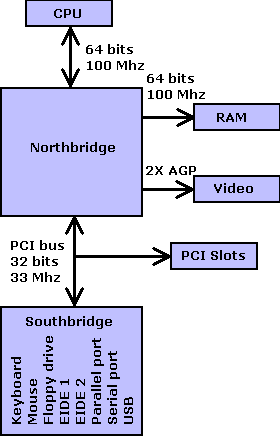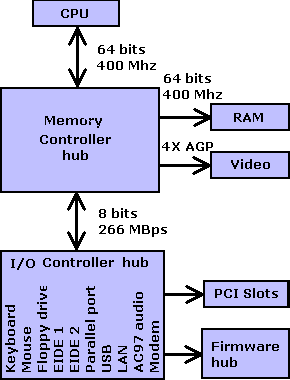Intel Chipsets
By Stephen Bucaro
The original 4.77 Mhz 8088-based IBM PC released in 1981 was built with over 100
discrete logic chips. To lower the cost of manufacturing, the logic was integrated
into a couple of chips that were used together as a set. They became referred to as
a chipset.
A Chipset is designed to work with specific CPU's and specific types of RAM. Intel
designed the 430 series of chipsets to support the Pentium CPU. Various versions of
the 430 chipsets provided different integrated support for PCI, USB, ATA, and other I/O.
The 440 series of chipsets introduced the Accelerated Graphics Port (AGP). The 440 series
had a long run, culminating in the April 1998 release of the BX version, which provided
support for the Pentium III and improved bus and memory speed from 66 Mhz to 100 Mhz.
The 430 chipset consists of a northbridge chip that connects to the CPU, memory, and
AGP graphics, and a southbridge chip that supports the ISA bus, PCI bus, and I/O
devices. The two chips communicated with each other over a 32 bit 33 Mhz PCI bus.

The connection between the nothbridge chip and the CPU is referred to as the
front-side bus. The front-side bus is 64 bits wide and 100 Mhz. The northbridge
connection to the CPU and main system memory is also 64 bits wide and 100 Mhz.
A 450 version, designed for the server market, featured 64-bit PCI slots intended for
high-speed network or RAID cards.
Intel 810 Chipset
The 820 chipset, announced in April 1999 does not use the northbrige/southbridge
configuration, but instead uses Intel's Accelerated Hub Architecture (AHA). The
Accelerated Hub Architecture has three main components, Memory Controller Hub, I/O
Controller Hub, and Firmware Hub.

Rather than communicating over the PCI bus, the MCH is connected to the I/O
Controller Hub (ICH) via a proprietary 266 Mhz 8-bit bus. It supported PC100 SDRAM.
processor support: Pentium III
System bus: 100 Mhz system bus
RAM: PC100 SDRAM
IDE: ATA-33 controller
AGP: 2X
USB: 2 USB controllers
AC97 six-channel audio
LAN interface
133 M Bytes per sec PCI
Soft modem connection
Later in 1999, Intel released the E (enhanced) version of the 810, which could support
bus and memory speeds up to 133 Mhz.
| 
